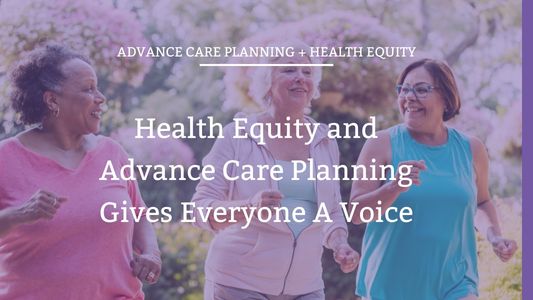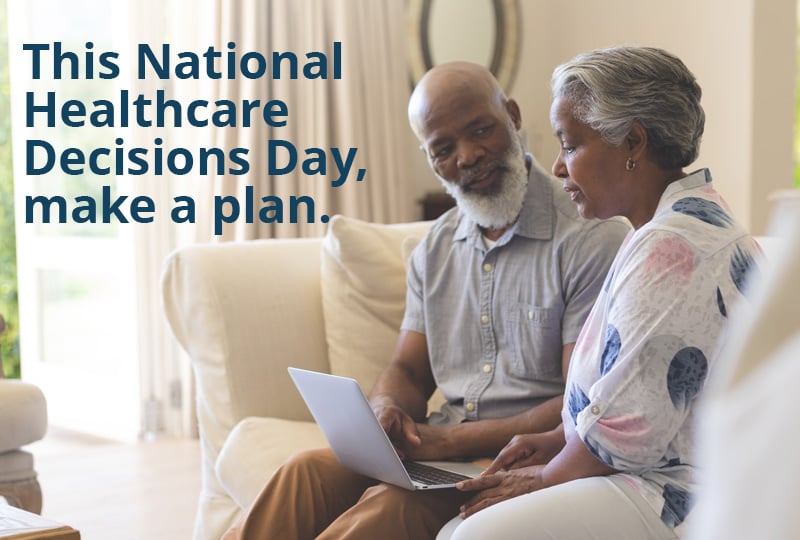5 min read
Health Equity and Advance Care Planning Gives Everyone A Voice

Healthcare providers and payers are well positioned to put the patient voice at the center of care. Generally, patients and members want healthcare to help prevent or cure an illness, reduce the probability of dying from disease or injury, minimize pain and negative symptoms, and extend their lives. Yet the relative importance of each of these is highly dependent on other health equity considerations including:
- Age
- Basic food, shelter, heat, and cooling provisions
- Desire for physical and emotional comfort and support
- Financial resources, or lack thereof
- Connection to family and friends
- Religious practices
- Transportation to medical appointments and pharmacy

When you engage with these patients and members struggling to overcome these obstacles, it’s easier to identify opportunities to avoid duplicative tests and procedures, as well as unwanted or unnecessary interventions. In so doing, you’ll have the opportunity to better coordinate care and reduce costs across the healthcare ecosystem.
Hear The Patient’s Voice and Values
When compared to Whites, African Americans report less satisfaction with the quality of communication, including the extent to which healthcare providers listen and share information, with greater disparities in racially discordant patient-provider relationships.
So how can you make advance care planning discussions more beneficial to both patients and providers? Experts focusing on improving communication with historically marginalized groups recommend healthcare providers and payers employ the following techniques:
- Respect. See the whole person not just their diagnosis, ethnicity, gender, socioeconomic circumstances, and other obstacles. Take what they share with you seriously.
- Listen. Ask questions for greater clarity. Don’t assume. Pay attention to their concerns, and to what’s really being said.
- Understand. Imagine yourself in their shoes, and how their unique situation could impact their well-being and healthcare decisions.
- Care. Take the initiative to connect patients and members to the resources they need to achieve their desired quality of life. Let them decide the level of care they’re most likely to accept and frequently engage with them.
When healthcare payers and providers utilize these approaches, here are some of the things they may hear.

Thoughtful conversations allow healthcare payers and providers to fulfill the promise of patient centered care focused on what the patient really values. Advance care planning helps ensure those values are honored when patients can’t speak for themselves.
Right to Choose and Change
It's important to keep in mind that the point of engaging in advance care planning discussions is not to force someone to make premature decisions about future medical care in hypothetical situations. Instead, when done well ACP allows everyone to identify a surrogate decision maker and to express their values.
These are not static decisions, but dynamic choices that change as patients and members confront serious illness, severe pain or physical impairment, cognitive decline, and their own mortality. Being comfortable, managing out-of-pocket expenses, safe and supportive food and housing arrangements, and honoring family, social, and spiritual commitments all factor into what patients and members’ value.
Advance care planning needs to accommodate changing values and ensure medical team access to the most current thinking. Unlike paper versions, digital advance care planning documents can be easily updated as circumstances change and values shift. Further, patient and member video recordings provide an opportunity to supplement written documents with explanations on the importance and thinking behind the decisions made so surrogates and the medical team can fully understand and truly honor their wishes.
In our work, there are several all too common and very real scenarios that impact a patient’s health care choices. To know what really adds value, we believe healthcare providers and payers must have access to tools easily capture and share the patient voice. Not doing so isn’t health equity.
You’ll want to tailor your interactions for patient and member circumstances. Generally, advance care planning falls into one of three types – Future, Urgent, and End-of-Life.
 1. Future Care Planning
1. Future Care Planning
Advance care planning isn’t just for the terminally ill. Accidents and unforeseen incidents can happen to anyone at any time. In fact, unexpected deaths from COVID-19 and unintentional injuries were the third and fourth leading cause of death in 2020, accounting for more than 16% of the approximately 3.4 million people who died.
Future care planning is important for everyone because it:
- Helps patients and members gain a better understanding of their current well-being, health, and illness.
- Allows individuals to name a Health Care Agent who can speak on their behalf should they become incapacitated.
- Lays the foundation for future conversations about medical goals, treatment priorities, and care preferences.
2. Urgent Care Planning
As the number of chronic diseases a patient or member endures increases, the greater the need for urgent care planning conversations. In fact, six in ten adults suffer from at least one chronic disease and 40% have two or more conditions.
Urgent care planning gives healthcare providers and payers the opportunity to advise patients and members on their illness trajectory, treatment limitations, and medical care options. Armed with this information, patients and members are better equipped to document decisions on:
- Preventative care options such as a mammogram or colonoscopy,
- Desired treatments and procedures including Cardio-pulmonary resuscitation (CPR), chemotherapy, and other life-sustaining treatment preferences, and
- Changes in Health Care Agent(s).
Because of their frequent interactions, longer appointment length, and role in supporting patients and members with chronic diseases, home health agency, skilled nursing facility, and chronic care management professionals are well positioned to facilitate these detailed discussions with both patients and their loved ones. Likewise, accountable care organization (ACO) physicians and community partners also share that vital role in coordinating urgent care planning across multiple points of care.
3. End-of-Life Planning
When one’s health steadily declines and the number and frequency of hospitalizations start rising it may be time to introduce end-of-life planning.
The number of people enrolled in hospice care for one day or more in 2019 was 1.61 million, an increase from 1.38 million in 2015. Given the prevalence of people suffering from chronic diseases, an estimated 6 million people annually could benefit from palliative care.
End-of-life care planning permits patients and members to discuss and document preferences for:
- Location of care and place of death at home, in an institutional, at a hospital, or another setting,
- Donation of all or select organs and tissues,
- The important quality of life and comfort choices, and
- How to care for someone after they’ve passed away.
Often facilitated by hospice and palliative care organizations, all healthcare providers and payers are committed to value-based care and health equity in end-of-life care. Each has a role to play in delivering end-of-life care planning.
The Best Tools for Advance Care Planning
Today’s technology allows everyone to choose, capture, change, and connect. Readily available digital advance care planning tools help democratize future, urgent, and end-of-life health care planning.
More and more healthcare payers and providers like you that are committed to health equity leverage the ADVault solution suite to support their advance care planning initiatives. Here’s six reasons why.

- Achievability. Current users have increased advance care planning completion rates from 35% to over 50% with structured, sustained, educational campaigns and MyDirectives invitations.
- Affordability. Select modular bundles to meet your specific user roles and avoid paying for functionality you don’t need at a small fraction of what competitors charge.
- Flexibility. Create new or upload existing ACP documents and portable medical orders. Patients and members easily access their accounts via the Internet to modify choices as circumstances change.
- Clarity. Summary for Physicians provides a quick snapshot of patient decisions for emergency response. Patient video recorded wishes enhance surrogate and medical team understanding.
- Accessibility. Real connection with every EHR in the healthcare ecosystem that doesn’t require a heavy technology lift and meets industry data exchange interoperability standards.
- Measurability. Automatic tracking of time spent and activities completed to systematically produce compliance reporting, as well as real-time performance dashboard analytics for actionable business insights that support management decision-making.
We invite you to explore all our ACP tools or schedule a demo to see for yourself how ADVault helps healthcare payers and provider fulfill the promise of health equity.
Let’s get started on digital ACP together
Secure, Interoperable, Accessible.
MyDirectives offers the only digital advance care planning (ACP) tools and interoperable cloud-based storage that is HITRUST Risk-Based 2-year Certified.






